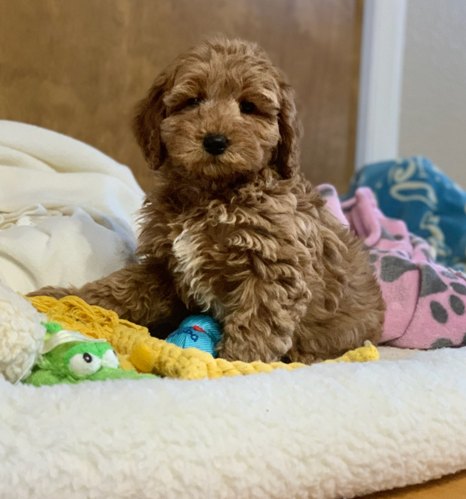There’s an old adage that when parents leave the maternity ward with their first newborn after they’ve carefully secured their infant into the newly purchased car seat that weighs as much as a mini-fridge they suddenly realize that no one provided an instructional manual for what happens next. While bringing your Labradoodle puppy home for the first time is certainly not as challenging or stressful, fortunately, useful tips are readily available.
Preparing the Space
Puppies are playful, frisky, and…um, untrained. They have the potential to bring tremendous joy to your household while also making a bit of a mess. Therefore, it’s wise to plan ahead by establishing an area of your home where your puppy can acclimate without unrealistic expectations.
When considering where your new arrival will spend most of its time, initially, consider the following traits:
- Puppies like to chew—purchase some toys that are puppy-friendly (preferably ones they can’t chew into and eat the cotton inside that can be harmful) and have them nearby.
- Puppies are not house-trained—it’s best to use floor space that’s easy to clean. Also, when they first come home it is the perfect opportunity to start crate training your new puppy. Have them in a crate from their first night, the type with bars so they can easily see you and a divider so they can grow into the crate.
- Puppies are social—consider an area of the house where your newest family member can spend ample time with you.
- Puppies like to explore—you may wish to temporarily restrict roaming access to other rooms.
- Puppies don’t love sleeping alone (at first)—you can have your puppy sleep near someone for the first couple of weeks, preferably in a crate that can be placed in someone’s bedroom. However, after the first few weeks find a space where you can permanently keep them in their crate, ideally not in your bedroom.
Preparing the “Equipment”
Just as new parents wouldn’t think of bringing a baby home without having a crib, pajamas, pacifier, and other necessities, those bringing home a puppy should purchase specific items before the new arrival takes its first steps in the new space.
There will probably be some experimentation in learning what’s most appealing to your puppy, but here are staples every home with a puppy should have:
- Stainless steel food and water bowls
- A black wire crate with a divider, one that your puppy can grow into, which you can get from Petco or Petsmart.
- A small bed or a blanket for your new crate, for added comfort and warmth
- Small or X-small Collar and leash for those first treks through the neighborhood
- Toys for the previously acknowledged chewing
- Treats for the soon-to-come training; we recommend Zukes training treats from Petsmart, Petco, or specialty pet stores.
Preparing for the Training
These early and unforgettable moments with your puppy are sure to be cheerful, but as you bond with your new best friend, keep in mind that there are practical measures that you can take to ensure that the newest member of your family is both cared for and learns about your expectations in this new environment.
Here are some common approaches to making this a seamless transition:
- Maintain a low profile at first. A loud or rambunctious home can be discomforting for a dog of any age in a new setting. It is recommended that the first time they come home, lie down and get horizontal at their level, this way you can pet them and they look at you as far less intimidating. Standing over them, they can think of you as a giant and become afraid of you.
- Get your puppy accustomed to their crate. Dogs enjoy the security and the consistency of a place to sleep or to stay when they’re alone, but they will need some reassurances at the outset.
- Start the house training process but maintain reasonable expectations at the outset. Consistency, routine, rewards, and praise will aid in this process. Remember your new puppy can only hold their “pee” for a couple of hours, so be prepared to take them out every few hours to potty.
- Find an area in your yard, preferably a path of finely crushed gravel and stone, where you can get your pet on a leash to go potty each time. In the beginning, use a leash, and a clicker with treats for training so when they go potty, they get a treat. Use the leash until your pet can go out to potty on the trail by themselves.
Of course, when it comes to bringing your puppy home, you’ll also want to get a reference to a quality vet as soon as possible, but implementing the above processes can alleviate a lot of the early challenges and will enhance your puppy’s transition into a loving environment.


